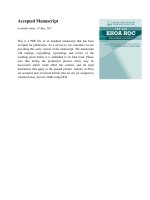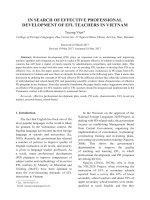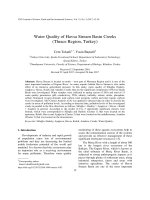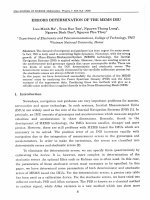AT quizzer (CPAR) test of controls procedure
Bạn đang xem bản rút gọn của tài liệu. Xem và tải ngay bản đầy đủ của tài liệu tại đây (34 KB, 6 trang )
Page 1 of 6
CPA REVIEW SCHOOL OF THE PHILIPPINES
Manila
AUDITING THEORY
TEST OF CONTROL PROCEDURES
Revenue and Receipt Cycle
1. After the auditor has prepared a flowchart of internal control for sales, and cash receipts
transactions and evaluated the design of the system, the auditor would perform tests of
controls on all control procedures
a. Documented in the flowchart.
b. Considered to be deficiencies that might allow errors to enter the accounting system.
c. Considered to be strengths that the auditor plans to rely on in assessing control risk.
d. That would aid in preventing irregularities.
2. Which of the following is not a universal rule for achieving control over cash?
a. Separate the cash-handling and record-keeping functions.
b. Deposit each day’s cash receipts by the end of the day.
c. Have bank reconciliation’s performed by employees who do not handle cash.
d. Decentralize the receiving of cash as much as possible.
3. The least crucial element of control over cash is
a. Separation of cash record keeping from custody of cash.
b. Preparation of the monthly bank reconciliation.
c. Separation of cash receipts from cash disbursements.
d. Batch processing of checks.
4. The use of fidelity bonds protects a company from embezzlement losses and also
a. Minimizes the possibility of employing persons with dubious records in positions of trust.
b. Protects employees who make unintentional errors form possible monetary damages
resulting from such errors.
c. Allows the company to substitute the fidelity bonds for various parts of internal control.
d. Reduces the company’s need to obtain expensive business interruption insurance.
5. An auditor is reviewing internal control for accounts receivable:
I. The billing function should not be assigned to the person who is responsible for maintaining
accounts receivable records.
II. Responsibility for approval of the write-off of accounts receivable that are uncollectible
should not be assigned to the cashier.
a. Only I is true
c. Both I and II are true
b. Only II is true
d. Neither I nor II is true
6. Which of the following is an effective internal control over accounts receivable?
a. Only persons who handle cash receipts should be responsible for the preparation of
documents that reduce accounts receivable balances.
b. Responsibility for approval of the write-off of uncollectible accounts receivable should be
assigned to the cashier.
c. Balances in the subsidiary accounts receivable ledger should be reconciled to the general
ledger control account once a year, preferably at year-end.
d. The billing function should be assigned to persons other than those responsible for
maintaining accounts receivable subsidiary records.
7. To achieve control when there is no billing department, the billing function should be performed
by the
a. Accounting department
c. Shipping department
b. Sales department
d. Credit and collection department
8. The person who opens the mail commonly prepares a remittance advice when a customer fails
to return one with a payment. Consequently, mail should be opened by the
a. Credit manager.
c. Sales manager.
b. Receptionist.
d. Accounts receivable clerk.
AT-5911
Page 2 of 6
9. Which of the following would the auditor consider to be an incompatible operation if the cashier
receives remittances from the mail room?
a. The cashier makes the daily deposit at a local bank.
b. The cashier prepares the daily deposit.
c. The cashier endorses the checks.
d. The cashier posts the receipts to the accounts receivable subsidiary ledger.
10. Which of the following would best protect a company that wishes to prevent lapping?
a. Segregating duties so that accounting has no access to an incoming mail
b. Segregating duties so that no employee has access both to checks from customers and to
currency from daily cash receipts
c. Having customers send payments directly to the company’s bank
d. Requesting that customers checks be made payable to the company and be addressed to
the treasurer
11. Defective merchandise returned by customers should be presented to
a. Inventory control personnel.
c. Purchasing personnel
b. Sales personnel.
d. Receiving personnel
12. In considering internal control within the revenue/receipt cycle, what is the purpose of a
transaction walk through?
a. To assure that employees are performing assigned functions accurately.
b. To confirm the auditor’s understanding of the internal control structure.
c. To select documents for detailed tests of controls.
d. To verify the results of the auditor’s sampling plan.
13. To determine whether internal control operates effectively to minimize errors of failure to bill a
customer for a shipment, the auditor would select a sample of transactions from the population
represented by the
a. Shipping records file
c. Sales invoice
b. Customer order file
d. Subsidiary customer accounts ledger
14. The purpose of tests of controls over shipping is to determine whether
a. Billed goods have been shipped.
b. Shipments are billed.
c. Shipping department personnel are competent.
d. Credit is approved before goods are shipped.
15. The purpose of tests of controls over billing is to determine whether
a. Billed goods have been shipped.
b. Shipments are billed.
c. Billing department personnel are competent.
d. Credit is approved before goods are billed.
16. Which of the following control procedures could prevent or detect errors or frauds arising from
shipments made to unauthorized parties?
a. Document policies and procedures for scheduling shipments.
b. Establish procedures for reviewing and approving prices and sales terms before sale.
c. Prenumber bills of lading and assure that related billings are made on a periodic basis.
d. Prepare and periodically update lists of authorized customers.
Expenditure and Disbursement Cycle
1. The accounts payable department receives a purchase order form to accomplish all of the
following except
a. Comparing invoice price to purchase order price.
b. Ensuring that the purchase had been properly authorized.
c. Comparing quantity ordered to quantity purchased.
d. Ensuring that the goods had been received by the party requesting the goods.
2. Which of the following is a primary function of the purchasing department?
a. Ensuring the acquisition of goods of a specified quality.
b. Authorizing the acquisition of goods.
c. Verifying the propriety of goods of a specified quality.
d. Reducing expenditures for goods acquired.
AT-5911
Page 3 of 6
3. Matching the suppliers’ invoice, the purchase order, and the receiving report normally should
be the responsibility of the
a. Receiving department
c. Accounting function
b. Purchasing department
d. Treasury function
4. The accounts payable department generally should
a. Cancel supporting documentation after a cash payment is mailed
b. Approve the price and quantity of each purchase requisition
c. Assure that the quantity ordered is omitted from the receiving department’s copy of the
purchase order
d. Agree the vendor’s invoice with the receiving report and purchase order
5. Internal control is improved when the quantity of merchandise ordered is omitted from the copy
of the purchase order sent to the
a. Department that initiated the requisition
c. Purchasing agent
b. Receiving department
d. Accounts payable department
6. When goods are received, the receiving clerk should match the goods with the
a. Purchase order and requisition.
b. Vendor’s invoice and the receiving report.
c. Vendor’s shipping document and the purchase order.
d. Receiving report and the vendor’s shipping documents.
7. The accounts payable department should compare the information on each vendor’s invoice
with the
a. Receiving report and the purchase order.
b. Receiving report and the vendor.
c. Vendor’s packing slip and the purchase order.
d. Vendor’s packing slip and the voucher.
8. The mailing of disbursement checks and remittance advices should be controlled by the
employee who
a. Signed the checks last
b. Approved the vouchers for payment
c. Matched the receiving reports, purchase orders, and vendor invoices
d. Verified the mathematical accuracy of the vouchers and remittance advices
9. What is the reason for ensuring that every copy of a vendor’s invoice has a receiving report?
a. To ascertain that merchandise billed by the vendor was received by the company.
b. To ascertain that merchandise received by the company was billed by the vendor.
c. To ascertain that the invoice was correctly prepared.
d. To ascertain that a check was prepared for every invoice.
10. How can an auditor test to determine whether Receiving Department procedures are applied
properly?
a. Test a sample of receiving documents.
b. Observe receiving procedures on a surprise basis.
c. Review procedures manuals.
d. Interview Receiving personnel.
11. Which of the following control procedures could prevent or detect payment of goods not
received?
a. Counting goods when received.
b. Matching the purchase order, receiving report, and vendor’s invoice.
c. Comparing goods received with goods requisitioned.
d. Verifying vouchers for accuracy and approval.
12. Which of the following would prevent a paid disbursement from being paid a second time?
a. Individuals responsible for signing checks should prepare vouchers.
b. Disbursements should be approved by at least two responsible officials.
c. The disbursement date should be within a few days of the date the voucher is presented for
payment.
d. The official signing the check should cancel the supporting documents.
AT-5911
Page 4 of 6
13. Assume an auditor’s interim consideration of internal control in the expenditure/disbursement
cycle reveals that control risk can be assessed below the maximum and detection risk above
the minimum for some assertions. Which of the following is true about substantive tests
applied to accounts payable?
a. The auditor is more apt to confirm payable balances.
b. The auditor is less apt to perform substantive tests at the balance sheet date.
c. The auditor is more apt to increase the extent of substantive tests.
d. The auditor is more apt to ignore the risk of incorrect acceptance when sampling accounts
payable.
14. A CPA learns that his client has paid a vendor twice for the same shipment, once based upon
the original invoice and once based upon the monthly statement. A control procedure that
should have prevented this duplicate payment is
a. Attachment of the receiving report to the disbursement support.
b. Prenumbering of disbursement vouchers.
c. Use of a limit or reasonableness test.
d. Prenumbering of receiving reports.
15. The authority to accept incoming goods in receiving should be based on a(n)
a. Vendor’s invoice
c. Bill of lading
b. Materials requisitions
d. Approved purchase order
Personnel and Payroll
1. Which of the following control procedures could best prevent direct labor from being charged to
manufacturing overhead?
a. Comparison of daily journal entries with factory labor summary.
b. Examination of routing tickets from finished goods on delivery.
c. Reconciliation of work in process inventory with cost records.
d. Recomputation of direct labor based on inspection of time cards.
2. For appropriate segregation of duties, journalizing and posting summary payroll transactions
should be assigned to
a. The treasurer’s department
c. Payroll accounting
b. General accounting
d. The timekeeping department
3. Low Tek, Inc. has changed from a conventional to a computerized payroll clock card system.
Factory employees now record time in and out with magnetic cards, and the computer system
automatically updates all payroll records. Because of this change,
a. The auditor must audit through the computer
b. Internal control has improved
c. Part of the audit trail has been lost
d. The potential for payroll related fraud has been diminished
4. To minimize the opportunities for fraud, unclaimed cash payroll should be
a. Deposited in a safe deposit box.
b. Held by the payroll custodian.
c. Deposited in a special bank account.
d. Held by the controller.
5. A common audit procedures in the audit of payroll transactions involves tracing selected items
from the payroll journal to employee time cards that have been approved by supervisory
personnel. This procedure is designed to provide evidence in support of the audit proposition
that
a. Only bona fide employees worked, and their pay was properly computed
b. Jobs on which employees worked were charged with the appropriate labor cost
c. Internal controls relating to payroll disbursements are operating effectively
d. All employees worked the number of hours for which their pay was computed
6. For internal control purposes, which of the following individuals should preferably be
responsible for the distribution of payroll checks?
a. Bookkeeper
c. Cashier
b. Payroll clerk
d. Receptionist
AT-5911
Page 5 of 6
7. The purpose of segregating the duties of hiring personnel and distributing payroll checks is to
separate the
a. Human resources function from the controllership function
b. Administrative controls from the internal accounting controls
c. Authorization of transactions from the custody of related assets
d. Operational responsibility from the record keeping responsibility
8. Which of the following departments most likely would approve changes in pay rates and
deductions from employee salaries?
a. Personnel
c. Controller
b. Treasurer
d. Payroll
9. Which of the following is not a common activity within personnel and payroll?
a. Initiating terminations.
b. Preparing and updating personnel records.
c. Preparing and recording payroll.
d. Distributing paychecks to employees.
10. Which of the following best describes proper internal control over payroll?
a. The preparation of the payroll must be under the control of the personnel department.
b. The confidentiality of employee payroll data should be carefully protected to prevent fraud.
c. The duties of hiring, payroll computation, and payment to employees should be segregated.
d. The payment of cash to employees should be replaced with payment by checks.
Production (Conversion) Cycle
1. Which of the following policies is an internal control weakness related to the acquisition of
factory equipment?
a. Advance executive approvals are required for equipment acquisitions.
b. Variances between authorized equipment expenditures and actual costs are to be
immediately reported to management.
c. Depreciation policies are reviewed only once a year.
d. Acquisitions are to be made through and approved by the department in need of the
equipment.
2. Which of the following procedures is most likely to ensure that employee job time tickets are
accurate?
a. Approve the payroll voucher in the accounts payable department.
b. Keep employment information in the human resources department.
c. Make sure that the number of hours per week on each employee’s job time ticket is 40.
d. Check the employee check cards against the job time tickets.
3. The objectives of the internal structure for a production cycle are to provide assurance that
transactions are properly executed and recorded, and that
a. Production orders are prenumbered and signed by a supervisor
b. Custody of work in process and of finished goods is properly maintained
c. Independent internal verification of activity reports is established
d. Transfers to finished goods are documented by a completed production report and a quality
control report
4. To strengthen control procedures over the custody of heavy mobile equipment, the client would
most likely institute a policy requiring a periodic
a. Increase in insurance coverage.
b. Verification of liens, pledges, and collateralizations.
c. Accounting for work orders.
d. Inspection of equipment and reconciliation with accounting records.
5. When perpetual inventory records are maintained in quantities and in dollars, and internal
control procedures over inventory are deficient, the auditor would probably
a. Want the client to schedule the physical inventory count at the end of the year.
b. Insist that the client perform physical counts of inventory items several times during the
year.
c. Increase the extent of tests for unrecorded liabilities at the end of the year.
d. Have to disclaim an opinion on the income statement that year.
AT-5911
Page 6 of 6
6. Which of the following activities is not common to the conversion cycle?
a. Maintaining perpetual inventory records.
b. Accounting for fixed asset disposals and retirements.
c. Recording depreciation allocations.
d. Implementing a just-in-time order entry system.
7. An auditor's tests of a client's cost accounting system are designed primarily to determine that
a. Quantities on hand have been computed based on acceptable methods that reasonably
approximate actual quantities on hand.
b. Physical inventories substantially agree with book inventories.
c. The system complies with generally accepted accounting principles and functions as
planned.
d. Costs have been assigned properly to finished goods, work in process, and cost of goods
sold.
8. An effective internal control procedures covering fixed asset additions should require:
a. Classification as investments of those fixed asset additions that are not used in the
business.
b. Capitalization of the cost of fixed asset addition in excess of a specific peso amount.
c. Performance of recurring fixed asset maintenance work solely by company maintenance
staff.
d. Authorization and approval of major fixed asset additions.
Investing and Financing Cycle
1. A company holds bearer bonds as a short-term investment. Responsibility for custody of these
bonds and submission of coupons for periodic interest collections probably should be
delegated to the
a. Chief accountant
c. Cashier
b. Internal auditor
d. Treasurer
2. Which of the following questions would an auditor most likely include on an internal control
questionnaire for notes payable?
a. Are assets that collateralize note payable critically needed for the entity’s continued
existence?
b. Are two or more authorized signatures required on checks that repay notes payable?
c. Are the proceeds from notes payable used for the purchase of noncurrent assets?
d. Are direct borrowings on notes payable authorized by the board of directors?
3. A company has additional funds to invest. The Board of Directors decided to purchase
marketable securities and assigned the future purchase and sale decisions to a responsible
financial executive. The best person(s) to make periodic reviews of the investment activity
should be
a. An investment committee of the Board of Directors.
b. The chief operating officer.
c. The corporate controller.
d. The treasurer.
4. When no independent stock transfer agents are employed and the corporation issues its own
stocks and maintains stock records, canceled stock certificates should
a. Not be defaced but segregated from other stock certificates and retained in a canceled
certificates file.
b. Be destroyed to prevent fraudulent reissuance.
c. Be defaced and sent to the secretary of state.
d. Be defaced to prevent reissuance and attached to their corresponding stubs.
5. In reviewing and evaluating internal control over marketable securities, the auditor would be
specially concerned about:
a. Recording of stock investments by the controller.
b. Approval of stock investment purchases by the Board of Directors.
c. Access to stock certificates by the corporate treasurer.
d. Access to stock certificates by the controller.
- end of AT-5911 -
AT-5911









